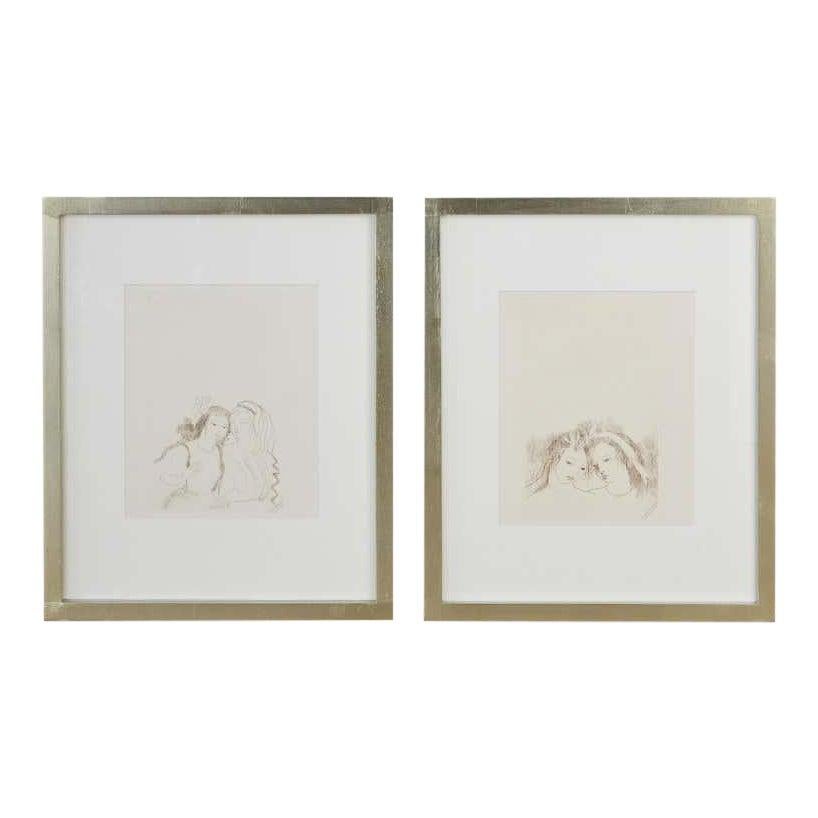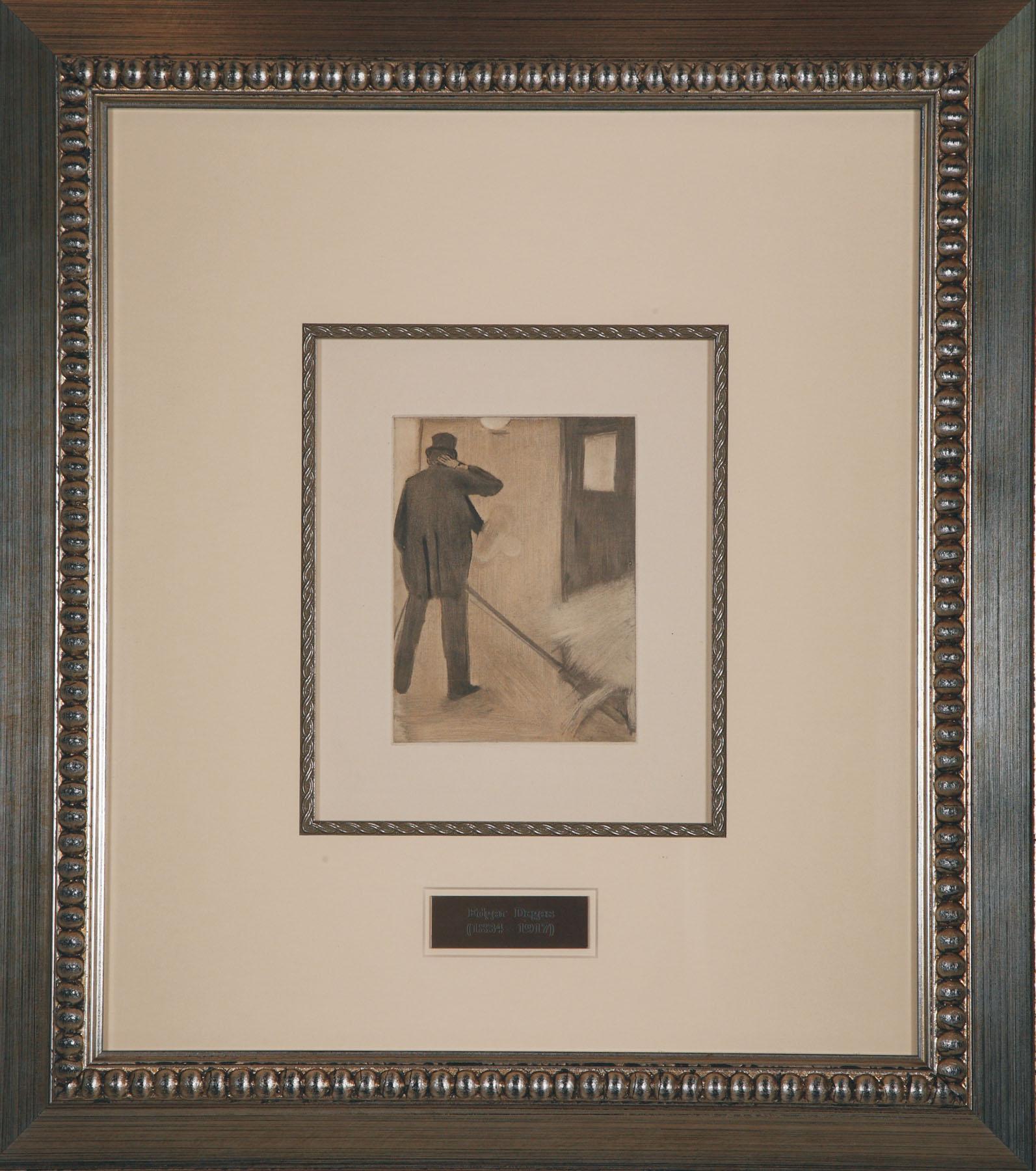Items Similar to Les pêcheurs de Concarneau by Georges Manzana Pissarro - Etching Print
Want more images or videos?
Request additional images or videos from the seller
1 of 4
Georges Manzana PissarroLes pêcheurs de Concarneau by Georges Manzana Pissarro - Etching Print1904
1904
About the Item
SOLD UNFRAMED
Les pêcheurs de Concarneau by Georges Manzana Pissarro (1871 - 1961)
Etching
22.5 x 17.7 cm (8 ⁷/₈ x 7 inches)
Inscribed and dated lower left, and signed lower right, manzana - Pissarro
Executed in 1904
Like all second-generation Pissarro artists, Georges Henri ‘Manzana’ Pissarro initially worked under a pseudonym. Born in 1871, Manzana was the third of Camille Pissarro’s seven children, adopting the name ‘Manzana’ in 1894 after the maiden name of his maternal grandmother. It was not until around 1910, to honour his deceased father, that he employed his family name when signing his work.
Manzana studied with his father from an early age and spent his formative years surrounded by the distinguished artists associated with the Impressionist movement – Claude Monet, Paul Cézanne, and Paul Gauguin – who frequented the Pissarro home in Éragny. At his father's side he learnt not only to handle brush and pencil but also to observe nature and its changing qualities.
Subjected to rich and diverse influences, Manzana became a prolific and versatile artist, working with oil, pastel and watercolour as well as etchings, lithography and stencils. As a young man he adopted his father's purely Impressionist style and produced a series of landscapes around Éragny. He exhibited Impressionist works at the Salon d'Automne and the Salon des Indépendants, as well as Durand Ruel and Druet galleries in Paris in the early 1900s.
In 1906 his work began to evolve. Inspired by Dr Mardus’ French translation of ‘A Thousand and One Nights’, Manzana embarked on a grand project to publish his own illustrated version of these magical tales. This pulled Manzana into the umbrella of the decorative arts movement where he flourished creating tapestries, glassware, furniture, ceramics and metal work, all inspired by Orientalism and often incorporating gold, silver and copper paint. In 1907 he had his first exhibition of decorative works at Vollard but it was the 1914 exhibition at the Musée des Arts Décoratifs in Paris which dramatically boosted his career. Here he exhibited 311 works including tapestries, carpets, furniture, glassware, decorative paintings, etchings and lithographs.
The subsequent years were filled with bright ideas, gilded costumes and a glittering lifestyle as Manzana navigated the 20s and 30s between Les Andelys and Paris, spending many summers in Brittany. These culminated in a series of colourful yet delicate new works which Manzana exhibited prolifically. When war broke out in 1939 Manzana moved with his family to Casablanca, where he remained until 1947. Manzana was married and widowed three times. The last years of his life were spent in Menton with his son Félix who was also an accomplished artist. There Manzana returned to the Impressionist tradition of his early years, painting the serene landscapes that surrounded him.
- Creator:Georges Manzana Pissarro (1871 - 1961, French)
- Creation Year:1904
- Dimensions:Height: 8.86 in (22.5 cm)Width: 6.97 in (17.7 cm)
- Medium:
- Period:
- Condition:
- Gallery Location:London, GB
- Reference Number:1stDibs: LU261212622702
About the Seller
5.0
Recognized Seller
These prestigious sellers are industry leaders and represent the highest echelon for item quality and design.
Platinum Seller
These expertly vetted sellers are 1stDibs' most experienced sellers and are rated highest by our customers.
Established in 1964
1stDibs seller since 2015
95 sales on 1stDibs
Typical response time: 4 hours
Associations
Society Of London Art Dealers
- ShippingRetrieving quote...Ships From: London, United Kingdom
- Return PolicyA return for this item may be initiated within 7 days of delivery.
More From This SellerView All
- Mare and Foal by Orovida Pissarro - Etching PrintBy Orovida PissarroLocated in London, GBSOLD UNFRAMED Mare and Foal by Orovida Pissarro (1893 - 1968) Etching 15.6 x 20.7 cm (6 ¹/₈ x 8 ¹/₈ inches) Artist's Biography Orovida Camille Pissarro, Lucien and Esther Pissarr...Category
20th Century Figurative Prints
MaterialsEtching
- Chatter by Orovida Pissarro - EtchingBy Orovida PissarroLocated in London, GBChatter by Orovida Pissarro (1893-1968) Etching 26 x 19 cm (10 ¹/₄ x 7 ¹/₂ inches) Signed and dated lower right Orovida 1927 Inscribed lower left Trial proof no. 18/25 and titled lower middle Artist biography: Orovida Camille Pissarro, Lucien and Esther Pissarro’s only child, was the first woman in the Pissarro family as well as the first of her generation to become an artist. Born in Epping, England in 1893, she lived and worked predominantly in London where she became a prominent member of several British arts clubs and societies. She first learned to paint in the Impressionist style of her father, but after a brief period of formal study with Walter Sickert in 1913 she renounced formal art schooling. Throughout her career, Orovida always remained outside of any mainstream British art movements. Much to Lucien's disappointment she soon turned away from naturalistic painting and developed her own unusual style combining elements of Japanese, Chinese, Persian and Indian art. Her rejection of Impressionism, which for the Pissarro family had become a way of life, together with the simultaneous decision to drop her famous last name and simply use Orovida as a ‘nom de peintre’, reflected a deep desire for independence and distance from the weight of the family legacy. Orovida's most distinctive and notable works were produced from the period of 1919 to 1939 using her own homemade egg tempera applied in thin, delicate washes to silk, linen or paper and sometimes embellished with brocade borders. These elegant and richly decorative works generally depict Eastern, Asian and African subjects, such as Mongolian horse...Category
1920s Post-Impressionist Figurative Prints
MaterialsEtching
- Man & Beast by Orovida Pissarro - EtchingBy Orovida PissarroLocated in London, GB*UK BUYERS WILL PAY AN ADDITIONAL 20% VAT ON TOP OF THE ABOVE PRICE Man & Beast by Orovida Pissarro (1893-1968) Etching 27 x 22 cm (10 ⁵/₈ x 8 ⁵/₈ inches) Signed and dated lower right, orovida 1924 Inscribed lower left, Final state no 12/40 and titled lower centre Artist biography: Orovida Camille Pissarro, Lucien and Esther Pissarro’s only child, was the first woman in the Pissarro family as well as the first of her generation to become an artist. Born in Epping, England in 1893, she lived and worked predominantly in London where she became a prominent member of several British arts clubs and societies. She first learned to paint in the Impressionist style of her father, but after a brief period of formal study with Walter Sickert in 1913 she renounced formal art schooling. Throughout her career, Orovida always remained outside of any mainstream British art movements. Much to Lucien's disappointment she soon turned away from naturalistic painting and developed her own unusual style combining elements of Japanese, Chinese, Persian and Indian art. Her rejection of Impressionism, which for the Pissarro family had become a way of life, together with the simultaneous decision to drop her famous last name and simply use Orovida as a ‘nom de peintre’, reflected a deep desire for independence and distance from the weight of the family legacy. Orovida's most distinctive and notable works were produced from the period of 1919 to 1939 using her own homemade egg tempera applied in thin, delicate washes to silk, linen or paper and sometimes embellished with brocade borders. These elegant and richly decorative works generally depict Eastern, Asian and African subjects, such as Mongolian horse...Category
1920s Post-Impressionist Animal Prints
MaterialsEtching
- The Hunting Prince by Orovida Pissarro - EtchingBy Orovida PissarroLocated in London, GBThe Hunting Prince by Orovida Pissarro (1893 - 1968) Etching 15 x 20 cm (5 ⅞ x 7 ⅞ inches) Signed and dated lower right Orovida 1926 Inscribed lower left Trial proof no.14 and titled lower middle Provenance: Private collection, Europe Artist biography: Orovida Camille Pissarro, Lucien and Esther Pissarro’s only child, was the first woman in the Pissarro family as well as the first of her generation to become an artist. Born in Epping, England in 1893, she lived and worked predominantly in London where she became a prominent member of several British arts clubs and societies. She first learned to paint in the Impressionist style of her father, but after a brief period of formal study with Walter Sickert in 1913 she renounced formal art schooling. Throughout her career, Orovida always remained outside of any mainstream British art movements. Much to Lucien's disappointment she soon turned away from naturalistic painting and developed her own unusual style combining elements of Japanese, Chinese, Persian and Indian art. Her rejection of Impressionism, which for the Pissarro family had become a way of life, together with the simultaneous decision to drop her famous last name and simply use Orovida as a ‘nom de peintre’, reflected a deep desire for independence and distance from the weight of the family legacy. Orovida's most distinctive and notable works were produced from the period of 1919 to 1939 using her own homemade egg tempera applied in thin, delicate washes to silk, linen or paper and sometimes embellished with brocade borders. These elegant and richly decorative works generally depict Eastern, Asian and African subjects...Category
1920s Animal Prints
MaterialsEtching
- Horse Pulling Hay Cart by Félix Pissarro - Animal etchingBy Félix PissarroLocated in London, GBHorse Pulling Hay Cart by Félix Pissarro (1874-1897) Etching 19.5 x 15 cm (7 ⅝ x 5 ⅞ inches) Exhibition London, Stern Pissarro Gallery, Camille Pissarro & hi...Category
1890s Post-Impressionist Animal Prints
MaterialsEtching
- Paysanne au puits by Camille Pissarro - EtchingBy Camille PissarroLocated in London, GBPaysanne au puits by Camille Pissarro (1830-1903) Etching 23 x 19.3 cm (9 x 7 ⁵/₈ inches) Stamped lower left, C.P. and numbered 8/50 Created in 1891 and printed at a later date as a...Category
1890s Impressionist Figurative Prints
MaterialsEtching
You May Also Like
- "Two Women" Pair EtchingsBy Marie LaurencinLocated in Rio Vista, CAElegant pair of etchings by Marie Laurencin (French 1883-1956) from the "Poemes de Sapho" published in 1950 ref. 273. Each beautifully mounted in fram...Category
20th Century Modern Portrait Prints
MaterialsEtching
- "Ludovic Halevy Backstage" from La Famille Cardinal after Edgar DegasBy (after) Edgar DegasLocated in Hinsdale, ILDegas, Edgar (after) (1834 -1917) "Ludovic Halevy Backstage" Monod 5797, Adhemar 71, Skira 58, Stern 25 Soft-Ground Etching created from a Monotype, 1938-9 First State. # 251 from ...Category
Early 20th Century Art Nouveau Figurative Prints
MaterialsEtching
- "Portrait of Madame Georges Menier" By HelleuBy Paul César HelleuLocated in Hinsdale, ILHELLEU, PAUL CÉSAR (1859 - 1927) MADAME GEORGES MENIER Montesquiou XXI Drypoint in colors, c. 1900 Signed in pencil, lower right Printed on wove paper Full Margins 22 1/4” x 13...Category
Early 19th Century Art Nouveau Figurative Prints
MaterialsDrypoint, Etching
- Coney Island, PP, Ed./50, 1935By Paul CadmusLocated in Washington Depot,, CTA printer's proof of an edition of 50. Depicting Cadmus' sense of humor and style. The beautiful frame dimensions are 18.5 x 19.5".Category
1930s American Realist Figurative Prints
MaterialsPaper, Etching
- Reclining NudeBy Raoul DufyLocated in New York, NYReclining Woman by Raoul Dufy (1877-1953) Etching on paper 5 ½ x 7 ½ inches unframed (13.716 x 19.05 cm) 13 ⅝ x 15 inches framed (34.6202 x 38.1 cm) Signed on bottom left Edition of ...Category
20th Century Figurative Prints
MaterialsEtching
- Sleeping FigureBy Jules PascinLocated in New York, NYSleeping Figure by Jules Pascin (1885-1930) Etching on paper 5 ½ x 4 inches unframed (13.97 x 10.16 cm) 13 ¼ x 12 inches framed (33.655 x 30.48 cm) D...Category
20th Century Figurative Prints
MaterialsEtching
Recently Viewed
View AllMore Ways To Browse
Max Chateau
French Art Deco Painting Lithograph Art
Lawyer Wall Art
Nicolas Toussaint Charlet
Decorative Wall Plates Fruit
James Mcqueen Print
Fina Miralles
Paper Cutout Light Box Picture
Pistol 16th Century
All Of Calders Paintings
The Seed Of Creation
Map Print Clothing
Picasso Signed Impression
Oriental Wood Figure
Rene Lenig
Dantes Inferno Prints
Textile Paintings Weaving Wall Art
Lithography Signed




